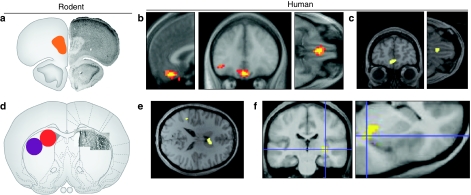Figure 1.
(a) Photomicrograph of an NMDA-induced cell body lesion of prelimbic prefrontal cortex (right hemisphere) and approximate region of lesion-induced damage (orange oval; left hemisphere) found to abolish the acquisition of goal-directed action in rats (cf. Balleine and Dickinson, 1998a, 1998b; Corbit and Balleine, 2003a, 2003b; Ostlund and Balleine, 2005). (b) Region of human vmPFC (here medial OFC) exhibiting a response profile consistent with the goal-directed system. Activity in this region during action selection for a liquid food reward was sensitive to the current incentive value of the outcome, decreasing in activity during the selection of an action leading to a food reward devalued through selective satiation compared to an action leading to a non-devalued food reward. From Valentin et al (2007). (c) Regions of human vmPFC (medial prefrontal cortex and medial OFC) exhibiting sensitivity to instrumental contingency and thereby exhibiting response properties consistent with the goal-directed system. Activation plots show areas with increased activity during sessions with a high contingency between responses and rewards compared with sessions with low contingency. From Tanaka et al (2008). (d) Photo-micrographs of NMDA-induced cell-body lesions of dorsomedial and dorsolateral striatum (right hemisphere) with the approximate region of lesion-induced damage illustrated in using red and purple circles, respectively (left hemisphere). This lesion of dorsomedial striatum has been found to abolish acquisition and retention of goal-directed learning (cf. Yin et al, 2005), whereas this lesion of dorsolateral striatum was found to abolish the acquisition of habit learning (Yin et al, 2004). (e) Region of human anterior dorsomedial striatum exhibiting sensitivity to instrumental contingency from the same study described in panel c. (f) Region of posterior lateral striatum (posterior putamen) exhibiting a response profile consistent with the behavioral development of habits in humans. From Tricomi et al, 2009.

